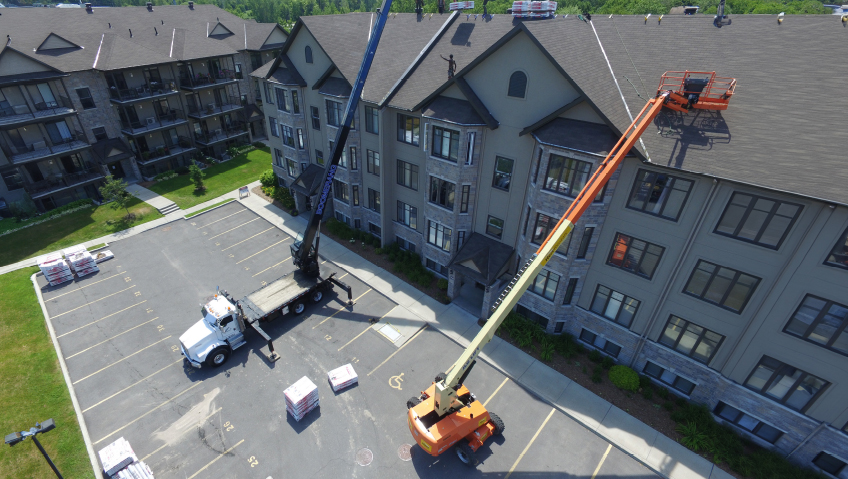It’s a towering achievement when all it takes is one look at the skyline of Calgary, Alberta, to see your company’s work. The Bow—the second tallest building in the city as of this writing—boasts 150,000 square feet of ACM (aluminum composite material) panels throughout the tower’s 57 floors, plus architectural panels in the lobby. All of these were made and installed by Igloo Erectors.
Brookfield Place—the tallest building in Calgary’s skyline—also boasts Igloo Erectors’ product in the top floors of the tower. The ICE Tower in Edmonton is another showcase project for the company, with ACM panels starting at 400 feet and going up the wall to 800 feet, as well as work in the lobby area.
Igloo Erectors also operates closer to ground level, with marquee projects like the Telus Spark Science Centre, the Calgary Airport Casino, and numerous automotive dealerships, schools, hospitals, malls, and even high-end homes rounding out the project list.
Richard Nesbitt is General Manager of Igloo Erectors. He entered the industry in 1980 and joined Igloo in 1998, and has seen dramatic changes in the construction industry, in both the work and the materials, in the decades since.
“We do a lot of standard siding, but a lot of custom panels as well,” he says. “In addition to ACM panels, we install phenolic panels, which have a wood grain appearance, as well. We’re also one of only a few approved applicators for Kalzip, a product we import from Europe.”
What sets Igloo Erectors apart from much of the competition is its fabrication capabilities. “We fabricate our own flashing, subgirts, and panels,” says Nesbitt. “We have our own standing seam roof machine, so we can produce panels on site.”
Up until now, Igloo Erectors has only had this fabrication capability in its Calgary location, but that’s about to change. “We’ve got another CNC machine on order,” Nesbitt shares. “We’ll be installing that machine here in Calgary and the one from here will be moved to our shop in Edmonton, so we’ll be able to cut and form material there as well.”
The technical capabilities of the company extend beyond fabrication. “With an ACM panel project, everything is cut to fit that project, so everything has to be measured. With scaffolding and man-lifts, it takes forever. With the digital building scanner we recently purchased, we can measure from the street in a few minutes.”
The company, and the industry in which it works, has come a long way from its initial form. The current owner, Dennis Hayden, began working in construction in Ontario with his father-in-law, installing metal roofs and walls and architectural cladding products.
When that company landed work on the Sheerness Power Plant in Hannah, Alberta, Dennis Hayden moved west to handle the job. And he never looked back.
“When Dennis was working on the project,” says Nesbitt, “he saw what Alberta was, how different it was from Ontario, and he decided that he wanted to stay once the project was finished.”
Hayden started his own company in 1987, and Igloo Erectors was born. Nesbitt joined a number of years later. “I was first introduced to Dennis around 1993. It took about five years, but Dennis convinced me to leave my job and come over to join him.”
When he joined the business, the company was just completing work on the BHP diamond mine in the Northwest Territories and in 2007, work started on the Snap Lake diamond mine. These were the last of the company’s major industrial projects, as he was hired to move Igloo Erectors into the supply and install business on commercial and Institutional projects. The company rented a small shop, began fabricating its own architectural panels and flashing, and business took off.
Earlier, with what turned out to be a stroke of foresight, Hayden had purchased a parcel of land near Calgary downtown. Igloo Erectors built its current head office and fabrication plant there, opened a second office in Edmonton, and the business continued to grow. Currently, the company takes on projects in Alberta, Saskatchewan, British Columbia, and the Northwest Territories.
When Hayden relocated from Ontario to Alberta, he was used to working with unionized trades and was a union member himself. It was his decision to form Igloo Erectors as a unionized business. When the recession in the early 1980s caused many of the businesses in the industry to become non-union, Igloo Erectors chose to buck the trend. It remains a unionized business to this day.
“We are the only unionized contractor in our trade doing commercial work,” Nesbitt says. “Every one of our competitors is non-union. Dennis has a lot of passion for the guys working out in the field. He wanted to give them something at the end of the day—pension, benefits, better pay.”
It’s challenging competing against so many non-union companies. Margins, already squeezed for every business, can be even narrower for Igloo Erectors. But the focus on more than just profit is what drew Nesbitt to the company in the first place. “Dennis has always been more concerned about providing a quality product that the owner and contractors are happy with than making all the money on every project. I liked that.”
On this arguably unbalanced playing field, however, the business competes effectively. The secret weapon: its people.
“We’re able to compete because we attract better workers and we keep them. Lots of our employees have been with us for 15, even 20 years and longer. Most companies in the industry can’t say that. We take pride in having so many long-term employees. They’re loyal, and they work their butts off.”
It’s not just the unionized status of outside workers that attracts and retains talented employees; Igloo has created a culture that expects people to do good work, trusts them to do so, and supports them when they need help. “We bring people on board, we give them freedom and the opportunity to learn and grow. We don’t hold their hands, but at the same time, we’re a team. Nobody’s ever left alone to solve a problem,” says Nesbitt.
Of course, the nature of the business itself has changed significantly over the course of three decades, and builders push to get work done as quickly as possible, putting pressure on every company involved in a project.
“Schedules are so condensed. What used to be a year has turned into six months. And we can only go as fast as the trade in front of us. If they’re delayed, the end date never changes. We have to make up the time at our own cost.”
Competition for the work is also more intense. For a job which, at one time, would have seen four or five bidders, Nesbitt says, Igloo Erectors is now one of 13 or 14 companies competing for the work. And many of those competitors are ‘truck and ladder guys,’ he says, without the foundation and facilities that Igloo Erectors has built.
All of these challenges are compounded by the fact that business is far less personal than it used to be. “We used to be in our customer’s face; we’d go to their office and spend time getting to know them. Now, everybody’s behind their computer. We don’t always know who we’re dealing with, and it’s harder to develop relationships.”
Supply chain challenges and skyrocketing costs in recent years have taken their toll as well. “We’re locked in on our prices. When we first quoted some jobs pre-COVID, we could buy material for $X per square foot. In the end, we had to buy it for 250 to 300 percent more per square foot,” Nesbitt shares. “We lost money on some jobs, but we managed, and we’re coming out of it.”
Igloo Erectors has 60-plus employees at present, and in the company’s words, a ‘growing arsenal of young talent.’ This is critical for the company because there are some transitions underway already, and more to come.
For instance, the company’s long-term field superintendent retired last year. And while Dennis Hayden remains involved in the business, he’s partially retired and no longer involved in the day-to-day operations. His son Scott Hayden, currently Operations Manager; Barry Bohane, Project Manager; and Carla Giebelhaus, Branch Manager in Edmonton, will take the reins at that time. Nesbitt plans to retire next year as well.
The company has been intentional about developing the capabilities of its young talent, though, and there’s a cohort that Nesbitt says is eager and ready to take on management roles.
Even Nesbitt acknowledges that he won’t be quite ready to leave the business entirely behind after so many years. “We’ve got a great up-and-coming team, but old talent doesn’t disappear. This is my baby. So even when I retire,” he chuckles, “there’s still going to be some ‘young old blood’ kicking around.”
The next generation of leadership is well-prepared to continue Igloo Erectors’ 37-year legacy. And an honest legacy it is.
“We stay focused and true to what our beliefs are. We never give up. We never walk away from a job. We stay with what we know, because we’re good at what we do. We won’t do something if we’re not 100 percent sure we can do it, and do it well.”






